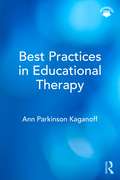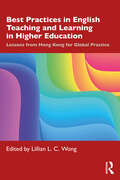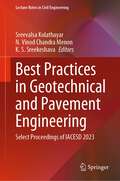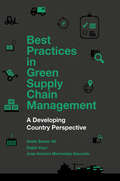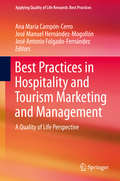- Table View
- List View
Best Practices in Designing Courses with Open Educational Resources (Best Practices in Online Teaching and Learning)
by Olena Zhadko Susan KoBest Practices in Designing Courses with Open Educational Resources is a practical guide that assists faculty and institutions looking to adopt and implement open educational resources (OER) and to foster meaningful, effective learning experiences through the course design process. Chapters loaded with tips, case examples, and guidance from practitioners advise readers through each step necessary for sustainable OER initiatives, from preliminary planning and course redesign through teaching, learning, and faculty development. Written by two authors with direct experience in training higher education professionals to use OER, this is a comprehensive resource for faculty, instructional designers, course developers, librarians, information technologists, and administrators hoping to rethink and refresh their curricula by moving beyond traditional textbooks. An authors’ website expands the book with resources, templates, and examples of implementation models, including faculty development workshop OER materials that can be adopted by readers.
Best Practices in Designing Courses with Open Educational Resources (Best Practices in Online Teaching and Learning)
by Olena Zhadko Susan KoBest Practices in Designing Courses with Open Educational Resources is a practical guide that assists faculty and institutions looking to adopt and implement open educational resources (OER) and to foster meaningful, effective learning experiences through the course design process. Chapters loaded with tips, case examples, and guidance from practitioners advise readers through each step necessary for sustainable OER initiatives, from preliminary planning and course redesign through teaching, learning, and faculty development. Written by two authors with direct experience in training higher education professionals to use OER, this is a comprehensive resource for faculty, instructional designers, course developers, librarians, information technologists, and administrators hoping to rethink and refresh their curricula by moving beyond traditional textbooks. An authors’ website expands the book with resources, templates, and examples of implementation models, including faculty development workshop OER materials that can be adopted by readers.
Best Practices in Educational Therapy
by Ann Parkinson KaganoffBest Practices in Educational Therapy provides actionable strategies and solutions for novice and veteran educational therapists. Given the diverse backgrounds of educational therapists and the varieties of specialization and client types, there is no single approach for all therapists and all clients. This book is built on a foundation of individualized intensive intervention, offering generalized principles of application across many contexts. Featuring practices informed by documented experiences of educational therapists as well as research in memory and cognition, attention, speech/language, specific syndromes, and the role of emotion in learning, this well-rounded guide will serve educational therapists at all stages in their career.
Best Practices in Educational Therapy
by Ann Parkinson KaganoffBest Practices in Educational Therapy provides actionable strategies and solutions for novice and veteran educational therapists. Given the diverse backgrounds of educational therapists and the varieties of specialization and client types, there is no single approach for all therapists and all clients. This book is built on a foundation of individualized intensive intervention, offering generalized principles of application across many contexts. Featuring practices informed by documented experiences of educational therapists as well as research in memory and cognition, attention, speech/language, specific syndromes, and the role of emotion in learning, this well-rounded guide will serve educational therapists at all stages in their career.
Best Practices in Engaging Online Learners Through Active and Experiential Learning Strategies (Best Practices in Online Teaching and Learning)
by Stephanie Smith Budhai Ke'Anna Brown SkipwithBest Practices in Engaging Online Learners Through Active and Experiential Learning Strategies, Second Edition, is a practical guide for all instructors, instructional designers, and online learning administrators designing, developing, teaching, and leading online, hybrid and blended learning courses and programs, who seek to provide supportive, engaging, and interactive learner experiences. This book explores the integration of active and experiential learning approaches and activities including simulations, gamification, social media integration, project-based learning, scenario-based learning, virtual tours, and online micro-credentialing as they relate to the development of authentic skill-building, communication, problem-solving, and critical-thinking skills in learners. New and emerging learning technologies of virtual and augmented reality along with artificial intelligence are included in this updated edition with examples of how instructors can actively use them in online courses to engage learners in experiential experiences. Readers will find guidelines for the development of participatory and peer-learning, competency-based learning, field-based experiences, clinical experiences, and service-learning opportunities in the online classroom. In addition, the authors provide effective learning strategies, discipline-specific examples, templates, and additional resources that align learner engagement with assessment practices and course outcomes.
Best Practices in Engaging Online Learners Through Active and Experiential Learning Strategies (Best Practices in Online Teaching and Learning)
by Stephanie Smith Budhai Ke'Anna Brown SkipwithBest Practices in Engaging Online Learners Through Active and Experiential Learning Strategies, Second Edition, is a practical guide for all instructors, instructional designers, and online learning administrators designing, developing, teaching, and leading online, hybrid and blended learning courses and programs, who seek to provide supportive, engaging, and interactive learner experiences. This book explores the integration of active and experiential learning approaches and activities including simulations, gamification, social media integration, project-based learning, scenario-based learning, virtual tours, and online micro-credentialing as they relate to the development of authentic skill-building, communication, problem-solving, and critical-thinking skills in learners. New and emerging learning technologies of virtual and augmented reality along with artificial intelligence are included in this updated edition with examples of how instructors can actively use them in online courses to engage learners in experiential experiences. Readers will find guidelines for the development of participatory and peer-learning, competency-based learning, field-based experiences, clinical experiences, and service-learning opportunities in the online classroom. In addition, the authors provide effective learning strategies, discipline-specific examples, templates, and additional resources that align learner engagement with assessment practices and course outcomes.
Best Practices in Engaging Online Learners Through Active and Experiential Learning Strategies (Best Practices in Online Teaching and Learning)
by Stephanie Smith Budhai Ke'Anna SkipwithBest Practices in Engaging Online Learners Through Active and Experiential Learning Strategies is a practical guide for all instructors and instructional designers working in online or blended learning environments who want to provide a supportive, engaging, and interactive learner experience. This book explores the integration of active and experiential learning approaches and activities including gamification, social media integration, and project- and scenario-based learning, as they relate to the development of authentic skill-building, communication, problem-solving, and critical-thinking skills in learners. Readers will find guidelines for the development of participatory peer-learning, cooperative education, and service learning opportunities in the online classroom. In addition, the authors provide effective learning strategies, resources, and tools that align learner engagement with course outcomes.
Best Practices in Engaging Online Learners Through Active and Experiential Learning Strategies (Best Practices in Online Teaching and Learning)
by Stephanie Smith Budhai Ke'Anna SkipwithBest Practices in Engaging Online Learners Through Active and Experiential Learning Strategies is a practical guide for all instructors and instructional designers working in online or blended learning environments who want to provide a supportive, engaging, and interactive learner experience. This book explores the integration of active and experiential learning approaches and activities including gamification, social media integration, and project- and scenario-based learning, as they relate to the development of authentic skill-building, communication, problem-solving, and critical-thinking skills in learners. Readers will find guidelines for the development of participatory peer-learning, cooperative education, and service learning opportunities in the online classroom. In addition, the authors provide effective learning strategies, resources, and tools that align learner engagement with course outcomes.
Best Practices in English Teaching and Learning in Higher Education: Lessons from Hong Kong for Global Practice
by Lillian L. C. WongLillian Wong brings together evidence- informed studies which are at the forefront of higher education developments in English language teaching and learning, and shares expertise from prominent academics in Hong Kong. Written by experienced practitioners who are active in the evolving field of scholarship of teaching and learning, it provides accessible and engaging insights into best practices in new and innovative areas, such as communities of practice, scholarship, big data analytics, digital literacies, blended learning, small private online courses, dialogic use of exemplars, students as tutors and critical thinking. The book covers best practices in three interrelated key areas in university English language education, including curriculum design and pedagogy, use of technologies and the teaching and learning of English in the disciplines. Linking theory and practice, the chapters discuss the emphasis on EAP/ ESP in university English language education, how technological developments are impacting the field and the implications for further research and the teaching of English in higher education. This resourceful collection is essential reading for teachers in- service and intraining, or those working in language education at the tertiary level where English is being used as an academic lingua franca, a medium of instruction or where EAP/ ESP plays an important role. Researchers in TESOL and applied linguistics, curriculum designers and leaders, teacher educators and policymakers as well as undergraduate and postgraduate students will also find it valuable.
Best Practices in English Teaching and Learning in Higher Education: Lessons from Hong Kong for Global Practice
by Wong, Lillian L. CLillian Wong brings together evidence- informed studies which are at the forefront of higher education developments in English language teaching and learning, and shares expertise from prominent academics in Hong Kong. Written by experienced practitioners who are active in the evolving field of scholarship of teaching and learning, it provides accessible and engaging insights into best practices in new and innovative areas, such as communities of practice, scholarship, big data analytics, digital literacies, blended learning, small private online courses, dialogic use of exemplars, students as tutors and critical thinking. The book covers best practices in three interrelated key areas in university English language education, including curriculum design and pedagogy, use of technologies and the teaching and learning of English in the disciplines. Linking theory and practice, the chapters discuss the emphasis on EAP/ ESP in university English language education, how technological developments are impacting the field and the implications for further research and the teaching of English in higher education. This resourceful collection is essential reading for teachers in- service and intraining, or those working in language education at the tertiary level where English is being used as an academic lingua franca, a medium of instruction or where EAP/ ESP plays an important role. Researchers in TESOL and applied linguistics, curriculum designers and leaders, teacher educators and policymakers as well as undergraduate and postgraduate students will also find it valuable.
Best Practices in Faculty Evaluation: A Practical Guide for Academic Leaders
by Jeffrey L. BullerPraise for Best Practices in Faculty Evaluation "Jeffrey Buller, a leading and respected voice in higher education, has written a truly practical and highly useful book on the increasingly important topic of faculty evaluation. This highly readable book is a 'must have/must read' book for every dean, chair, and faculty member in all institutions of higher education." —Robert E. Cipriano, author, Facilitating a Collegial Department in Higher Education: Strategies for Success; former chair of Southern Connecticut State University's Recreation and Leisure Studies Department "Buller has done it again. This latest book meets a never-ending need of all colleges and universities. It's the best treatment I've ever found of the critical dynamics of faculty evaluations—the associated history and philosophy, but especially how to get it right when conducting pretenure, tenure, and posttenure reviews. Every P&T committee, every chair, every dean will welcome a copy." —R. Kent Crookston, author, Working with Problem Faculty: A Six-Step Guide for Department Chairs; director of the Academic Administrative Support Program at the Brigham Young University Faculty Center "Finally, a comprehensive volume replete with practical ideas and seasoned advice about how to effectively handle faculty performance evaluations. This author really understands the lack of preparation and confidence that most academic administrators feel when asked to function as both judge and coach. If you need concrete strategies for dealing with all aspects of the evaluation process, this book won't disappoint you. The content and case studies are right on the money."—Christine Licata, author, Post-Tenure Faculty Review and Renewal; senior associate provost, Rochester Institute of Technology
Best Practices in Faculty Evaluation: A Practical Guide for Academic Leaders
by Jeffrey L. BullerPraise for Best Practices in Faculty Evaluation "Jeffrey Buller, a leading and respected voice in higher education, has written a truly practical and highly useful book on the increasingly important topic of faculty evaluation. This highly readable book is a 'must have/must read' book for every dean, chair, and faculty member in all institutions of higher education." —Robert E. Cipriano, author, Facilitating a Collegial Department in Higher Education: Strategies for Success; former chair of Southern Connecticut State University's Recreation and Leisure Studies Department "Buller has done it again. This latest book meets a never-ending need of all colleges and universities. It's the best treatment I've ever found of the critical dynamics of faculty evaluations—the associated history and philosophy, but especially how to get it right when conducting pretenure, tenure, and posttenure reviews. Every P&T committee, every chair, every dean will welcome a copy." —R. Kent Crookston, author, Working with Problem Faculty: A Six-Step Guide for Department Chairs; director of the Academic Administrative Support Program at the Brigham Young University Faculty Center "Finally, a comprehensive volume replete with practical ideas and seasoned advice about how to effectively handle faculty performance evaluations. This author really understands the lack of preparation and confidence that most academic administrators feel when asked to function as both judge and coach. If you need concrete strategies for dealing with all aspects of the evaluation process, this book won't disappoint you. The content and case studies are right on the money."—Christine Licata, author, Post-Tenure Faculty Review and Renewal; senior associate provost, Rochester Institute of Technology
Best Practices in Geotechnical and Pavement Engineering: Select Proceedings of IACESD 2023 (Lecture Notes in Civil Engineering #449)
by Sreevalsa Kolathayar N. Vinod Chandra Menon K. S. SreekeshavaThis book presents select proceedings of the International Conference on Interdisciplinary Approaches in Civil Engineering for Sustainable Development (IACESD 2023). The topics covered include emerging practices in geotechnical engineering and pavement, innovative approaches, and technologies to enhance the durability, sustainability, and performance of infrastructure, geosynthetics, geotechnical monitoring systems, and ground improvement techniques to address soil stability, settlement, and liquefaction issues. This book is useful for researchers and professionals’ geotechnical engineering.
Best Practices in Gifted Education: An Evidence-Based Guide
by Ann Robinson Bruce M. Shore Donna EnersenA gifted education Legacy Award winner, Best Practices in Gifted Education provides concise, up-to-date, research-based advice to educators, administrators, and parents of gifted and talented youth. The 29 practices included in this volume are the result of an extensive examination of educational research on what works with talented youth. The interest in culturally diverse and low-income learners, the means to identify talents, and the need for curriculum that appropriately challenges high-ability youth constitute just a few of the 29 practices.Each practice is organized into a chapter containing two sections: What We Know and What We Can Do. The first section briefly describes the practice and summarizes the research. The second section suggests what course of action a parent, teacher, or administrator might take at home, in the classroom, or at school. The book is a must-have for those who want a guide that makes a connection between research and practical action in gifted education.A service publication of the National Association for Gifted Children (Washington, DC). This designation indicates that this book has been jointly developed with NAGC and that this book passes the highest standards of scholarship, research, and practice.
Best Practices in Gifted Education: An Evidence-Based Guide
by Ann Robinson Bruce M. Shore Donna EnersenA gifted education Legacy Award winner, Best Practices in Gifted Education provides concise, up-to-date, research-based advice to educators, administrators, and parents of gifted and talented youth. The 29 practices included in this volume are the result of an extensive examination of educational research on what works with talented youth. The interest in culturally diverse and low-income learners, the means to identify talents, and the need for curriculum that appropriately challenges high-ability youth constitute just a few of the 29 practices.Each practice is organized into a chapter containing two sections: What We Know and What We Can Do. The first section briefly describes the practice and summarizes the research. The second section suggests what course of action a parent, teacher, or administrator might take at home, in the classroom, or at school. The book is a must-have for those who want a guide that makes a connection between research and practical action in gifted education.A service publication of the National Association for Gifted Children (Washington, DC). This designation indicates that this book has been jointly developed with NAGC and that this book passes the highest standards of scholarship, research, and practice.
Best Practices in Green Supply Chain Management: A Developing Country Perspective
by Sadia Samar Ali Rajbir Kaur Jose Antonio Marmolejo SaucedoMeeting consumer needs and desires, while promoting cleaner production and sustainable consumption, is one of the greatest challenges facing industry today. Addressing poverty and environmental degradation requires changing how global organizations produce and distribute goods and how people and organizations consume and dispose of them. It requires a more efficient use of resources, together with action-oriented thinking but raises a range of highly specific challenges for organizations operating in emerging economies. Best Practices in Green Supply Chain Management offers new insights on the challenges of integrating environmental awareness into supply chain management operations in developing countries. The authors present in-depth case studies from the Indian and Mexican manufacturing industries, which are used to illustrate broader lessons in the implementation of sustainable practices for developing economies. This book presents detailed findings and practical guidance to both researchers and practitioners working in the fields of business management, sustainability and green practices, as well as all those who wish to understand why organizations should integrate sustainable strategies and how to implement them.
Best Practices in Green Supply Chain Management: A Developing Country Perspective
by Sadia Samar Ali Rajbir Kaur Jose Antonio Marmolejo SaucedoMeeting consumer needs and desires, while promoting cleaner production and sustainable consumption, is one of the greatest challenges facing industry today. Addressing poverty and environmental degradation requires changing how global organizations produce and distribute goods and how people and organizations consume and dispose of them. It requires a more efficient use of resources, together with action-oriented thinking but raises a range of highly specific challenges for organizations operating in emerging economies. Best Practices in Green Supply Chain Management offers new insights on the challenges of integrating environmental awareness into supply chain management operations in developing countries. The authors present in-depth case studies from the Indian and Mexican manufacturing industries, which are used to illustrate broader lessons in the implementation of sustainable practices for developing economies. This book presents detailed findings and practical guidance to both researchers and practitioners working in the fields of business management, sustainability and green practices, as well as all those who wish to understand why organizations should integrate sustainable strategies and how to implement them.
Best Practices in Hospitality and Tourism Marketing and Management: A Quality of Life Perspective (Applying Quality of Life Research)
by Ana María Campón-Cerro José Manuel Hernández-Mogollón José Antonio Folgado-FernándezThis volume analyses the positive effects that tourism generates on resident’s quality of life, and how this influences tourists’ quality of life as they enjoy an enriching experience in the destination they visit. It provides significant theoretical and empirical contributions, as well as, case studies related to quality of life in hospitality and tourism marketing and management. This volume is the result of the effort that many researchers from all over the world have done to spread some new light on this outstanding research line and add knowledge on the relationship between tourism and quality of life of both residents and tourists. This last is highlighted as a fundamental factor to take into account for the development of new tourism practices. This volume is a true reference for researchers, students and professionals working in tourism marketing and management.
Best Practices in Leadership Development and Organization Change: How the Best Companies Ensure Meaningful Change and Sustainable Leadership (J-B US non-Franchise Leadership #18)
by Louis Carter David Ulrich Marshall GoldsmithIn this important book, successful organizations—including well-known companies such as Agilent Technologies, Corning, GE Capital, Hewlett Packard, Honeywell Aerospace, Lockheed Martin, MIT, Motorola, and Praxair—share their most effective approaches, tools, and specific methods for leadership development and organizational change. These exemplary organizations serve as models for leadership development and organizational change because they Commit to organizational objectives and culture Transform behaviors, cultures, and perceptions Implement competency or organization effectiveness models Exhibit strong top management leadership support and passion
Best Practices in Leadership Development and Organization Change: How the Best Companies Ensure Meaningful Change and Sustainable Leadership (J-B US non-Franchise Leadership)
by Dave Ulrich Marshall Goldsmith Louis CarterIn this important book, successful organizations—including well-known companies such as Agilent Technologies, Corning, GE Capital, Hewlett Packard, Honeywell Aerospace, Lockheed Martin, MIT, Motorola, and Praxair—share their most effective approaches, tools, and specific methods for leadership development and organizational change. These exemplary organizations serve as models for leadership development and organizational change because they Commit to organizational objectives and culture Transform behaviors, cultures, and perceptions Implement competency or organization effectiveness models Exhibit strong top management leadership support and passion
Best Practices in Lean Manufacturing: A Relational Analysis (SpringerBriefs in Applied Sciences and Technology)
by José Roberto Díaz-Reza Jorge Luis García Alcaraz Adrián Salvador Morales GarcíaThis book reports four structural equation models (SEM) for quantifying the relationship between the most important lean manufacturing (LM) practices applied to the manufacturing industry. The SEMs are evaluated using 220 responses to a survey applied to manufacturing companies applying LM principles in the production system and are related to: distribution and maintenance, production process and quality system, supply chain and quality, and an integrator model. The findings identify the most important activities for every LM practices and how they are related. These relationship’ values will help administrators, managers, engineers to focus their efforts on these most important activities, facilitating the decision-making process.
Best Practices in Lean Six Sigma Process Improvement: A Deeper Look
by Richard J. SchonbergerBest Practices in Lean Six Sigma Process Improvement reveals how to refocus lean/six sigma processes on what author Richard Schonberger—world-renowned process improvement pioneer—calls "the Golden Goals": better quality, quicker response, greater flexibility, and higher value. This manual shows you how it can be done, employing success stories of over 100 companies including Apple, Illinois Tool Works, Dell, Inc., and Wal-Mart, all of which have established themselves as the new, global "Kings of Lean," surpassing even Toyota in long-term improvement.
Best Practices in Lean Six Sigma Process Improvement: A Deeper Look
by Richard J. SchonbergerBest Practices in Lean Six Sigma Process Improvement reveals how to refocus lean/six sigma processes on what author Richard Schonberger—world-renowned process improvement pioneer—calls "the Golden Goals": better quality, quicker response, greater flexibility, and higher value. This manual shows you how it can be done, employing success stories of over 100 companies including Apple, Illinois Tool Works, Dell, Inc., and Wal-Mart, all of which have established themselves as the new, global "Kings of Lean," surpassing even Toyota in long-term improvement.
Best Practices in Management Accounting
by Greg N. Gregoriou, Nigel FinchManagement accounting has undergone significant evolution moving away from rigid budgeting programs and static output measures to comprehensive approaches of value identification and measurement. The book provides case studies, commentary and analysis from international experts in management accounting across the contemporary focus areas.
Best Practices in Manufacturing Processes: Experiences from Latin America
by Jorge Luis García Alcaraz Leonardo Rivera Cadavid Rosa Guadalupe González-Ramírez George Leal Jamil Mario Gustavo Chong ChongThis book reports the best practices that companies established in Latin America are implementing in their manufacturing processes in order to generate high quality products and stay in the market. It lists the technologies, production and administrative philosophies that are being implemented, presenting a collection of successful cases of studies from Latin America. The book describes how the tools and techniques are being integrated, modified and combined to create new technical resources for assisting the decision making process for better economic performance in manufacturing companies. The efforts deployed for assisting the transformation of raw materials into products and services are described. The authors explain the main key success factors or drivers for success of each tool, technique or hybrid combination approach applied to solve manufacturing problems.

